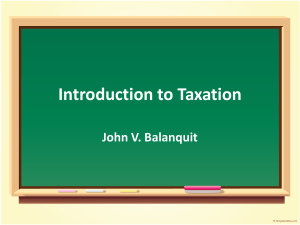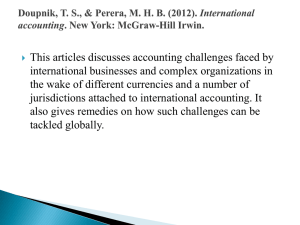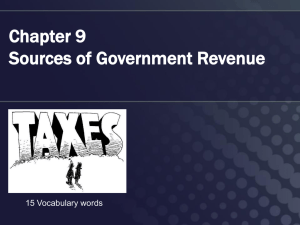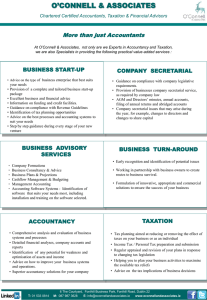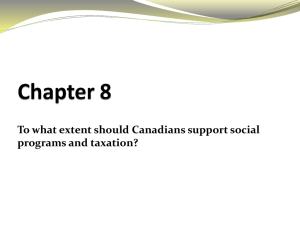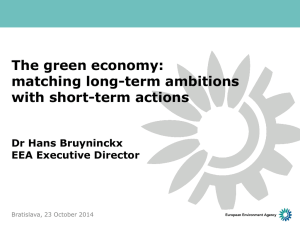PRINCIPLES of TAXATION
advertisement
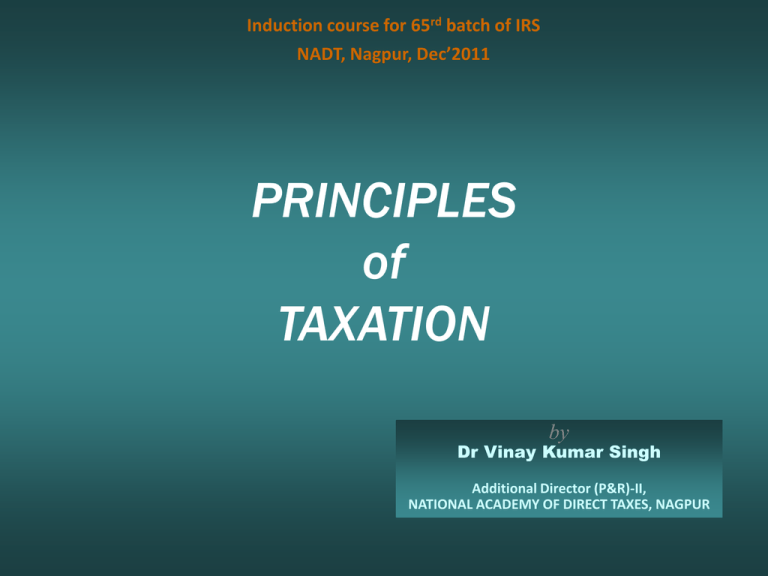
Induction course for 65rd batch of IRS
NADT, Nagpur, Dec’2011
PRINCIPLES
of
TAXATION
by
Dr Vinay Kumar Singh
Additional Director (P&R)-II,
NATIONAL ACADEMY OF DIRECT TAXES, NAGPUR
We will try to cover…
Principles of taxation
• Concept of tax
• Need for taxes
– Role of Government : Public goods & Redistribution of income
– Behaviour modification
•
•
•
•
•
•
•
•
•
•
Alternatives to tax
Tax design & classification
Economics of taxation
Laffer curve
Characteristics of an ideal tax
Tax elasticity Vs. Tax buoyancy
Voluntary compliance Vs. Administered compliance
Tax avoidance Vs. Tax evasion
Economics of deterrence
Globalization & taxes
We will try to cover…
Principles of taxation
• Concept of tax
• Need for taxes
– Role of Government : Public goods & Redistribution of income
– Behaviour modification
•
•
•
•
•
•
•
•
•
•
Alternatives to tax
Tax design & classification
Economics of taxation
Laffer curve
Characteristics of an ideal tax
Tax elasticity Vs. Tax buoyancy
Voluntary compliance Vs. Administered compliance
Tax avoidance Vs. Tax evasion
Economics of deterrence
Globalization & taxes
What is a tax ?
TAX
Principles of taxation
Tax is a compulsory charge on resources (usually money) imposed
by an authority on people without a quid pro quo exchange of
goods/ services.
Characteristics of tax
I.
II.
III.
IV.
V.
Compulsory
Charge on resources, usually money
Imposed by an ‘authority’
Imposed on people
No good or service provided in exchange of tax in a
quid pro quo manner
Different from a ‘fees’ which is charged in exchange of goods
or services provided on a ‘quid pro quo’ basis
Why are there taxes ?
We will try to cover…
Principles of taxation
• Concept of tax
•Need for taxes
– Role of Government : Public goods & Redistribution of income
– Behaviour modification
•
•
•
•
•
•
•
•
•
•
Alternatives to tax
Tax design & classification
Economics of taxation
Laffer curve
Characteristics of an ideal tax
Tax elasticity Vs. Tax buoyancy
Voluntary compliance Vs. Administered compliance
Tax avoidance Vs. Tax evasion
Economics of deterrence
Globalization & taxes
What do we need a tax ?
NEED FOR TAXES
Principles of taxation
Private individual Vs. Social Institutions
– Consumption & Production are private activities
– What is required from social institutions to help
these ‘private’ activities ?
– How can society provide this help ?
– What are the main social institutions ?
• Family
– Tribes, communities
• Market
• Government
What is the role of market ?
NEED FOR TAXES
Principles of taxation
The role of Markets
– Transaction cost of buying & selling
– Consumption efficiency
– Markets allow people to buy what they want
– Allocation of resources for consumption which maximizes
welfare
– Production efficiency
– Markets allow producers to produce what is ‘in demand’
– Efficient production least wastage; efficient resources in
production
Markets allow people to ‘privately’ consume and produce goods which
allow people to consume what they prefer, within the given
resources available
Efficient markets maximize social welfare
What is the role of Government ?
NEED FOR TAXES
Principles of taxation
The role of Government
1. Public Goods
• Not rivaled
• Not excludable
– National defense; Law & order (protection of property rights); Regulations
– Roads, Broadcasting
– Free-rider problem need financing from Society-Governments
2. Redistribution of Income
• Markets do not alter initial endowment
– Often worsen INEQUITY Rich have capital Returns on
capital further worsen the difference between rich & poor
Why do we need redistribution of income ?
NEED FOR TAXES
Principles of taxation
The role of Government
3. In case of Market failures
• Public goods are not provided efficiently by market
• EXTERNALITIES: Benefit / Harm to society of private actions
(consumption / production)
– Positive Externality : benefit to society
– Negative Externality : harm / loss to society
• Monopolies: produce less, charge more, society loses, INEFFICIENT
– ‘Economy of scale’ industries
• Information asymmetry: Efficient markets require perfect
information
• Asset Bubbles & Busts
How do we finance the Government?
We will try to cover…
Principles of taxation
• Concept of tax
• Need for taxes
– Role of Government : Public goods & Redistribution of income
– Behaviour modification
• Alternatives to tax
•
•
•
•
•
•
•
•
•
Tax design & classification
Economics of taxation
Laffer curve
Characteristics of an ideal tax
Tax elasticity Vs. Tax buoyancy
Voluntary compliance Vs. Administered compliance
Tax avoidance Vs. Tax evasion
Economics of deterrence
Globalization & taxes
Can taxes be avoided?
ALTERNATIVES TO TAX
Principles of taxation
Ways of financing Government
– TAX
– Fees & charges
e.g. Fees for healthcare, fees for schools, electric / water charges
– Borrowing
– DOMESTIC
– EXTERNAL
–
–
–
–
Aid / donations
Business profits (from PSEs)
Lease or Sale of assets / Disinvestment
Seigniorage (printing of currency)
– INFLATION TAX
– Penalties
Why taxes ?
ALTERNATIVES TO TAX
Ways of financing
Government
– TAX
– Fees &
charges
– Borrowing
– Aid /
donations
– Business
profits
(from PSEs)
PEOPLE NOT READY TO PAY FOR PUBLIC GOODS
AVOIDABLE UNPREDICTABLE AMOUNT
DEBT NEEDS TO BE PAID BACK
DANGER OF DEBT TRAP
UNPREDICTABLE AMOUNT
VERY UNPREDICTABLE
FIRST NEEDS INVESTMENT;
RISK OF LOSSES
GOVERNMENT USUALLY NOT GOOD IN DOING BUSINESS
– Lease or Sale
of assets
– Seigniorage
NOT SUSTAINABLE IN LONG RUN
IF ALL ASSETS ARE SOLD GOVT WITH NO AUTHORITY
– Penalties
AVOIDABLE UNPREDICTABLE AMOUNT
(printing of
currency)
PRINTING OF CURRENCY INRCREASES MONEY
SUPPLY INFLATION EVERYONE LOSES
INFLATION TAX
What about taxes ?
Principles of taxation
ALTERNATIVES TO TAX
Ways of financing
Government
– TAX
– Fees &
charges
– Borrowing
– Aid /
donations
– Business
profits
(from PSEs)
– Lease or Sale
of assets
– Seigniorage
(printing of
currency)
– Penalties
Principles of taxation
SUSTAINABLE
PREDICTABLE
ALLOWS AUTONOMY NO OBLIGATION FOR
SERVICES OR SUPPLY
CREATES NO LIABILITIES (for later generations)
NEEDS NO INVESTMENT (by earlier generation)
AUTONOMY FROM DONORS’ REQUIREMENTS
DOES NOT NEED GOVT TO DO BUSINESS
(which it is not good at)
DOES NOT REQUIRE ANY SALES OF ASSETS
NO INFLATION
CAN BE COLLECTED WITHOUT RULE BREAKING
LESS ECONOMIC INEFFICIENCY
CAN BE MORE EQUITABLE
Negative aspect of taxes ?
ALTERNATIVES TO TAX
Ways of financing
Government
– TAX
– Fees &
charges
– Borrowing
– Aid /
donations
– Business
profits
(from PSEs)
– Lease or Sale
of assets
– Seigniorage
NO QUID PRO QUO IN RETURN MOST DETESTED
USUALLY DISTORTS ECONOMIC BEHAVIOUR
can be economically inefficient
OFTEN REQUIRES COMPLEX LAWS, RULES &
PROCEDURES
COMPLIANCE & ADMINISTRATIVE COSTS
real burden on the society
PROBLEMS:
TAX (LEGAL) DISPUTES
TAX EVASION
TAX AVOIDANCE
CORRUPTION
(printing of
currency)
– Penalties
Principles of taxation
SHOULD WE HAVE TAXES ?
ALTERNATIVES TO TAX
Principles of taxation
Ways of financing
Government
– TAX
– Fees &
charges
– Borrowing
– Aid /
donations
– Business
profits
(from PSEs)
– Lease or Sale
of assets
– Seigniorage
(printing of
currency)
– Penalties
REVENUE IS THE BACKBONE OF ADMISTRATION
We will try to cover…
Principles of taxation
• Concept of tax
• Need for taxes
– Role of Government : Public goods & Redistribution of income
– Behaviour modification
• Alternatives to tax
• Tax design & classification
•
•
•
•
•
•
•
•
Economics of taxation
Laffer curve
Characteristics of an ideal tax
Tax elasticity Vs. Tax buoyancy
Voluntary compliance Vs. Administered compliance
Tax avoidance Vs. Tax evasion
Economics of deterrence
Globalization & taxes
How are taxes designed ?
TAX DESIGN
Principles of taxation
TAX DESIGN
Set of rules on the basis of which a tax is charged from the
people
RULE BASED TAX
ARBITRARY TAX
Tax imposed by a set of rules
Rules avoid arbitrariness in
taxation
Increase objectivity
Make it more predictable
Reduce dissatisfaction & disputes
Reduce cost of tax collection
Allow better planning
Limit discretion of tax collector
Create TAXPAYER RIGHTS
REQUIRE RULES
Tax imposed without any rules
Arbitrariness in taxation
Increase subjectivity
Make it less predictable
Increase dissatisfaction &
disputes
Increase cost of tax collection
Planning is very difficult
High discretion of tax collector
No TAXPAYER RIGHTS
Do NOT REQUIRE RULES
What kind of rules ?
TAX DESIGN
TAX DESIGN
Note:
Set of rules on the basis of which a
tax is charged from the people
BASIC DESIGN
TAX =
Principles of taxation
TAX BASE
X
TAX RATE
SPECIFIC FEATURES
ALL OTHER FEATURES THAT AFFECT
TAX LIABILITY OF TAXPAYERS
EXEMPTIONS OF TAX-BASE
DEDUCTIONS FROM TAX LIABILITY
DIFFERENTIAL TAX RATES
VARIABLE TAX RATES
OTHER SPECIAL PROVISIONS
Tax design refers to Rules that
decide who will pay tax and
how much
Tax design does not include
“procedural rules” which
decide the following:
-how and when the tax will
be paid
-to whom
-when
-what if not paid
-who will collect
-who will decide if there is a
dispute / mistake
- what procedure needs to
be followed, by whom &
how
What is a tax base?
TAX DESIGN
Principles of taxation
TAX BASE
ELEMENT ON WHICH TAX IS IMPOSED
A person is taxed on the basis of presence of
the tax base
e.g. income, wealth (different from income),
property owned, property transacted,
livestock, sales, purchases, manufacturing,
trade, exports, imports, services,
transportation, vehicles, fuel, water,
inheritance, interest and expenditure,
windows
What is a LUMP SUM TAX ?
TAX DESIGN
Principles of taxation
TAX BASE
ELEMENT ON WHICH TAX IS IMPOSED
CHARACTERISTICS OF A TAX BASE
1. VARIABLE
2. LINKED WITH ECONOMIC ACTIVITY
Consumption of value
Production of value
Storage / owning of value
Transfer of value
3. OBJECTIVE QUANTIFICATION
POSSIBLE
Why not tax unhappiness, anger, jealousy?
TAX DESIGN
Principles of taxation
TAX RATE
TAX CHARGED ON PER UNIT OF TAX
BASE
Usually expressed as ‘percentage’ or ‘proportion’
e.g. 20% (one-fifth) or 33.3% (one-third) per annum;
Or
as amount of tax per unit of tax base,
e.g. one ounce of silver for every acre of land
Rs. 1000 for every square feet of commercial
property
What can be the range of tax rate ?
TAX DESIGN
Principles of taxation
TAX RATE
TAX CHARGED ON PER UNIT OF TAX BASE
FIXED RATE – Rate does not change with a change in quality
or quantity of tax base
VARIABLE RATE – Rate changes with a change in the
quantity of tax base
PROGRESSIVE: Tax rate increases with increase in
quantity of tax base
DEGRESSIVE: Tax rate increases with increase in quantity
of tax base, but the rate of this “increase” reduces with
rise of tax base
REGRESSIVE: Tax rate falls with increase in quantity of
tax base
DIFFERENTIAL RATE – Tax rate changes with quality
(characteristics) of tax base
e.g. Capital gains, Agricultural income
Custom duty of different goods imported
What about income-tax rates?
TAX DESIGN
Principles of taxation
SPECIFIC FEATURES
EXEMPTIONS OF TAX-BASE
TAX BASE ON WHICH NO TAX IS LEVIED
TYPES
PERSON SPECIFIC
e.g. charitable trust exempted from income-tax
ACTIVITY SPECIFIC
e.g. income from exports exempt from income-tax
QUANTITY SPECIFIC
e.g. Income not charged up to a certain limit
QUALITY SPECIFIC
e.g. Vacant unused land exempt from property tax
Any other examples?
TAX DESIGN
Principles of taxation
SPECIFIC FEATURES
DEDUCTIONS FROM TAX LIABILITY
REDUCTION OF THE TAX PAYABLE ON THE
BASIS OF PRESENCE OR ABSENCE OF
SOME OTHER PRE-REQUISITES, WITHOUT
AFFECTING THE TAX BASE AND TAX RATE,
AS PER PREDEFINED RULES
e.g. deductions from income-tax on the basis of
savings / medical expenditure / investment in
special industry or backward areas / expenditure
for research / charitable donations
Why is tax design important ?
TAX DESIGN
Principles of taxation
SIGNIFICANCE OF TAX DESIGN
AFFECTS ECONOMIC EFFICIENCY OF TAX
Exemptions, deductions, differential tax rates
cause distortion of economic behavior
AFFECTS DISTRIBUTION OF TAX BURDEN IN
THE SOCIETY
Progressive tax more equitable (rich pay
more tax than poor)
AFFECTS COSTS OF COMPLIANCE &
ADMINISTRATION
Simple design easy to comply & administer
less costs
Why do we have complex tax designs?
Principles of taxation
TAX
RATE
TAX DESIGN
30%
TAX
PAYABLE
20%
10%
DEDUCTION FROM TAX LIABILITY
INCOME
(TAX BASE)
QUALITY BASED
EXEMPTION OF
TAX BASE
QUANTITY BASED
EXEMPTION OF
TAX BASE
1.6
Lac
3
Lac
5
Lac
Why do we have complex tax designs?
TAX CLASSIFICATION
Principles of taxation
Many different ways
–
–
–
–
–
–
–
–
–
–
Benefit based taxation Vs Faculty based taxation
Direct Vs Indirect
Primary Vs Secondary
Tax on person Vs Tax on property Vs Tax on income
Tax on value at different times:
‘On acquisition’ Vs ‘for possession’ Vs ‘On consumption’
Proportioned Vs Apportioned
Tax on “goods” Vs Tax on “bads”
Tax on capital Vs Tax on labour
Progressive Vs Digressive Vs Regressive
Accounts based taxes Vs Physical verification based taxes
What is a DIRECT tax?
TAX CLASSIFICATION
DIRECT TAX
Principles of taxation
INDIRECT TAX
Collected from the person
who bears its burden
(taxpayer pays it from his
own resources)
Usually Linked with a
resource – current or
expected
More predictable
Levied per unit of time
Collected from the person
who does not bear its burden
(taxpayer collects it from
others and pays)
Usually Linked with a
transaction – as & when it
takes place
Less predictable
Levied per transaction
EXAMPLES
EXAMPLES
Wealth tax, Income tax,
Property tax, Land tax,
Corporate tax, Gift tax,
Interest tax, Expenditure tax
Sales tax, Central or State Excise,
Property transaction tax
(Stamp Duty), Value Addition
Tax (VAT), Consumption tax
What about Inheritance tax?
We will try to cover…
Principles of taxation
• Concept of tax
• Need for taxes
– Role of Government : Public goods & Redistribution of income
– Behaviour modification
• Alternatives to tax
• Tax design & classification
• Economics of taxation
•
•
•
•
•
•
•
Laffer curve
Characteristics of an ideal tax
Tax elasticity Vs. Tax buoyancy
Voluntary compliance Vs. Administered compliance
Tax avoidance Vs. Tax evasion
Economics of deterrence
Globalization & taxes
What are the economic effects of taxes ?
ECONOMICS OF TAXATION
PRICE
MARKET DYNAMICS IN A PERFEC T MARKET
SOCIAL
WELFARE
= CS + PS
SUPPLY (MC)
CONSUMER
SURPLUS
P
MARKET
EQUILIBRIUM
PRODUCER
SURPLUS
DEMAND (MB)
Q
QUANTITY
When is the market perfect ?
Principles of taxation
ECONOMICS OF TAXATION
Principles of taxation
MARKET DYNAMICS after a TAX is imposed on transactions
PRICE
SOCIAL
WELFARE
= CS + PS
+ REV
SUPPLY AFTER TAX
(MC + TAX)
SUPPLY (MC)
CS
After-tax P
Tax
P
NEW MARKET EQUILIBRIUM
TAX REV
People consume less
People produce less
DWL
Total welfare from
private economic
activities falls
PS
ECONOMY SHRINKS
DEMAND (MB)
Q’
What is ‘DWL’?
QUANTITY
ECONOMICS OF TAXATION
Principles of taxation
MARKET DYNAMICS after a TAX is imposed on transactions
DEAD WEIGHT LOSS
LOSS OF ECONOMIC
ACTIVITY RESULTING
FROM THE
DISINCENTIVE
RESULTING FROM TAX
When are the effects of taxes on economy ?
ECONOMICS OF TAXATION
Principles of taxation
EFFECTS OF TAX ON ECONOMY
– Tax increase the ‘cost’ of
consumption / production
– Prices rise
– “TRANSFER” of resources from
‘people’ to ‘government’
– Finance Govt. activities Public
goods, Redistribution
– TAX ‘disincentivize’ economic
activities Dead weight loss
What is significance of DWL?
ECONOMICS OF TAXATION
Principles of taxation
EFFECTS OF TAX ON ECONOMY
– Dead weight loss is the real
“COST” of a tax
– Other ‘real costs’ of taxes :
• COST of ADMINISTRATION
• COST OF COMPLIANCE
All taxes lead to some distortion of
economic activities, which distorts
the market equilibrium, market
efficiency and social welfare
Should we have taxes?
ECONOMICS OF TAXATION
Principles of taxation
WHEN TO TAX & HOW MUCH ?
– TAX is justified if
Benefits from tax are more than the costs of tax
BENEFITS
– Public goods / service
– Social welfare gain from
redistribution
– Gain from modification of
behaviour
COSTS
–
–
–
–
Dead weight loss
Cost of administration
Cost of compliance
Losses from modification of
behaviour
Who bears the burden of the tax ?
ECONOMICS OF TAXATION
Principles of taxation
PRICE
TAX INCIDENCE - the burden of taxation in a market
SUPPLY AFTER TAX
(MC + TAX)
SUPPLY (MC)
CS
PRICE FOR BUYER
Tax burden (INCIDENCE) on buyers
Tax
Tax burden (INCIDENCE) on sellers
PRICE FOR SELLER
PS
DEMAND (MB)
Q’
QUANTITY
What does this ‘TAX INCIDENCE’ depend upon?
ECONOMICS OF TAXATION
Principles of taxation
TAX INCIDENCE (BURDEN) ALWAYS FALLS ON THE ‘SURPLUS’ (CS / PS)
PRICE
Flatter (ELASTIC) SUPPLY curve Less PRODUCER SURPLUS Less TAX BURDEN
ON SELLER
SUPPLY AFTER TAX
(MC + TAX)
SUPPLY (MC)
CS
PRICE FOR BUYER
Tax burden (INCIDENCE) on buyers
Tax
Tax burden (INCIDENCE) on sellers
PRICE FOR SELLER
PS
DEMAND (MB)
QUANTITY
Q’
Flatter (ELASTIC) DEMAND curve Less CONSUMER SURPLUS Less TAX BURDEN
ON BUYER
What about income-tax?
ECONOMICS OF TAXATION
Principles of taxation
EFFECTS OF INCOME-TAX ON ECONOMY : The usual argument
• Tax on income reduces incentive to work
• Work (& income) come at the cost of LEISURE (free time)
• Everybody would like to have both income & leisure has to
make a choice between the two
• Principle of diminishing returns: The marginal value of both
leisure & income falls with more of it
• As one works more, the leisure he has reduces & income rises
the marginal value of income falls while marginal value of leisure
rises
• Till the time, marginal value of income is more than the marginal
value of leisure, he is willing to work more
• When the marginal value of income becomes less than marginal
value of leisure, he reduces his wok to a point where marginal
value of income EQUALS marginal value of leisure
• Income-tax reduces the marginal value of income so the
person is likely to work less
Any other arguments? What does empirical evidence suggest ?
ECONOMICS OF TAXATION
Principles of taxation
EFFECTS OF INCOME-TAX ON ECONOMY
The usual argument : Tax on income reduces incentive to work
Depends upon whether income & leisure are ‘SUBSTITUTES’ or
‘COMPLIMENTS’
If they are substitutes, income-tax will disincentivize work
If they are compliments, income-tax can actually make the person
work more
( e.g.. Imagine a person with family. Fall in income (by tax) leads to fall in
living standard. Instead of living in a smaller flat or shifting children to
a cheaper school, the person may prefer to work overtime or take up
some extra work)
In real life, they are probably partly substitute & partly
complements, so effect is mixed
Empirical evidence suggests that in real life, income-tax does not
change the work supply in case of full time workers, but it
reduces the work supply by part time workers ( retired /
students / housewives)
How?
ECONOMICS OF TAXATION
Principles of taxation
LEISURE
(HOURS)
EFFECT OF INCOME-TAX on willingness of people to work
assuming income & work are SUBSTITUTES
INDIFFERENCE CURVES
WORKING HOURS
when No Income-tax
LOSS OF WORK DUE
TO INCOME-TAX
BUDGET CONSTRAINT
with income-tax
BUDGET CONSTRAINT
without income-tax
0
INCOME
Income-Tax
What if they are compliments?
ECONOMICS OF TAXATION
Principles of taxation
LEISURE
(HOURS)
EFFECT OF INCOME-TAX on willingness of people to work
assuming income & work are COMPLIMENTS
INDIFFERENCE CURVES
WORKING HOURS
when No Income-tax
BUDGET CONSTRAINT
with income-tax
ADDITION OF WORK
DUE TO INCOME-TAX
BUDGET CONSTRAINT
without income-tax
0
INCOME
Income-Tax
What is LAFFER CURVE?
We will try to cover…
Principles of taxation
• Concept of tax
• Need for taxes
– Role of Government : Public goods & Redistribution of income
– Behaviour modification
• Alternatives to tax
• Tax design & classification
• Economics of taxation
• Laffer curve
•
•
•
•
•
•
Characteristics of an ideal tax
Tax elasticity Vs. Tax buoyancy
Voluntary compliance Vs. Administered compliance
Tax avoidance Vs. Tax evasion
Economics of deterrence
Globalization & taxes
What are the economic effects of taxes ?
LAFFER CURVE
Principles of taxation
REVENUE
EFFECTS OF INCREASING TAX RATE
BEYOND A POINT, HIGHER
TAX RATES LEAD TO
LOWER TAX REVENUE
Higher tax rates disincentivize
economic activity, leading to shrinking
of tax base
( e.g.. Will you do business if tax rate is
96% ? ….remember, government does not
share your RISK )
Max
Revenue
LAFFER CURVE
0
Revenue maximizing TAX RATE
Higher tax rate can lead to :
Greater dead weight loss
Greater tendency to EVADE TAX
Greater costs of admin, compliance
TAX RATE
What is our own experience?
We will try to cover…
Principles of taxation
• Concept of tax
• Need for taxes
– Role of Government : Public goods & Redistribution of income
– Behaviour modification
•
•
•
•
Alternatives to tax
Tax design & classification
Economics of taxation
Laffer curve
• Characteristics of an ideal tax
•
•
•
•
•
Tax elasticity Vs. Tax buoyancy
Voluntary compliance Vs. Administered compliance
Tax avoidance Vs. Tax evasion
Economics of deterrence
Globalization & taxes
What are the economic effects of taxes ?
IDEAL TAX
CHARACTERISTICS OF AN IDEAL TAX
Economically efficient
Equitable
Neutral
Generates adequate revenue Predictably
Simple to comply and administer
-Minimum cost of administration
-Minimum cost of compliance
Can we achieve all ?
Principles of taxation
IDEAL TAX
Principles of taxation
CHARACTERISTICS OF AN IDEAL TAX
ECONOMICALLY EFFICIENT
- A tax is economically efficient when it does not create any
disincentives against economic activity by people
-For a perfectly efficient tax
Dead weight loss = zero
-In case of an economically efficient tax the resources taken up
by the government exactly equal the reduction in resources
employed for private economic activities
-There is some economic inefficiency associated with all taxes
Which tax is most efficient ?
IDEAL TAX
Principles of taxation
CHARACTERISTICS OF AN IDEAL TAX
EQUITABLE
- A tax is equitable when it is borne only as per the ability to pay
-For a perfectly EQUITABLE tax
If two persons have different amount of resources, the
‘additional resources’ of the richer will be taxed first, and
when they are exhausted, the remaining tax will fall equally
on both
-An equitable tax leads to Redistribution of resources
-Redistribution of resources creates a disincentive against
economic activity
Which tax is most equitable ?
IDEAL TAX
Principles of taxation
CHARACTERISTICS OF AN IDEAL TAX
NEUTRAL
-A tax is neutral when the burden of tax on two persons with
equal resources is equal, irrespective of their economic activities,
and other characteristics (like age, gender, education, race, religion, caste,
profession, marital status, place of residence, preferences for consumption, production
and wealth)
-For a perfectly NEUTRAL tax
Two persons with equal resources will always be taxed equally
irrespective of whatever they are and whatever they may do
-A neutral tax is usually more economically efficient
-Very difficult to have a tax that is neutral to economic
preferences
Can we achieve all ?
IDEAL TAX
Principles of taxation
CHARACTERISTICS OF AN IDEAL TAX
ADEQUATE & PREDICTABLE
-A tax should ideally be able to collect sufficient resources for the
Government financing in a predictable manner
-For an ADEQUATE & PREDICTABLE tax
A single tax is sufficient, so multiplicity of taxes and the
multiplicity of costs associated with them are avoided. The
revenue collected is exactly as predicted
-A single adequate & predictable tax is always preferable, if other
objectives are also fulfilled
- Every tax can be avoided by modifying economic activities, so a
single tax may be less predictable than a combination of taxes
Most predictable tax ?
IDEAL TAX
Principles of taxation
CHARACTERISTICS OF AN IDEAL TAX
SIMPLE TO COMPLY & ADMINISTER
-A tax should ideally be simple to comply for the tax payer, simple
to administer for the tax administrator, with no difficulties in
interpretation and no possibility of legal disputes
-For an ideally SIMPLE tax
Cost of compliance = zero
Cost of administration = zero
-Simple tax requires simple tax design, simple law and simple
procedure of reporting
- Simple tax design may not be economically efficient, equitable,
neutral and adequate
Which is an ideal tax ?
IDEAL TAX
Principles of taxation
CHARACTERISTICS OF AN IDEAL TAX
No ideal tax
Since no single tax achieves the characteristics of an ideal tax
alone, so Governments resort to multiple taxes with the aim
of
-Minimizing economic efficiency
-Achieving more neutrality
-Achieving Equity
-Minimizing evasion & ensuring adequacy & predictability
of revenue
-This can increase costs of compliance & administration
Which is an ideal tax combination ?
We will try to cover…
Principles of taxation
• Concept of tax
• Need for taxes
– Role of Government : Public goods & Redistribution of income
– Behaviour modification
•
•
•
•
•
Alternatives to tax
Tax design & classification
Economics of taxation
Laffer curve
Characteristics of an ideal tax
• Tax elasticity Vs. Tax buoyancy
•
•
•
•
Voluntary compliance Vs. Administered compliance
Tax avoidance Vs. Tax evasion
Economics of deterrence
Globalization & taxes
What are the economic effects of taxes ?
TAX BUOYANCY & ELASTICITY
Principles of taxation
TAX BUOYANCY
Change in tax revenue in response to one unit change in tax base
% changein T ax Revenue
T ax Buoyancy
% changein T ax Base
( For National statistics, the tax base usually taken is GDP, as a proxy to the economic
activity – remember most tax-bases are related to economic activity)
Higher Tax Buoyancy (More than 1)
Tax Revenue rises faster than the economic growth
As economy grows, the Government can expand its activities OR reduce tax rates
Low Tax Buoyancy (Less than 1)
Tax Revenue rises slower than the economic growth
As economy grows, the Government will need to cut down its activities OR increase
tax rates
(Note : Data for different years should be adjusted for INFLATION )
How do we calculate Tax Buoyancy ?
TAX BUOYANCY & ELASTICITY
Principles of taxation
TAX BUOYANCY
Change in tax revenue in response to one unit change in tax base
T ax Buoyancy
% changein T ax Revenue
% changein T ax Base
CALCULATING TAX BUOYANCY : MANY DIFFERENT WAYS
(i) Calculate Tax Buoyancy for different years, then take an average
(ii) Calculate Tax Buoyancy for the duration by using data at the beginning
and at the end of that period
(iii) As (ii) above, but using ‘averaged’ data, e.g.. Use average of first two
years , and use average of last two years
(iv) Using Regression techniques
(i) Regress log of Tax Revenue on the year
(ii) Regress log of Tax Revenue on the log of the Tax Base (GDP)
Which method is preferable ?
TAX BUOYANCY & ELASTICITY
Principles of taxation
TAX ELASTICITY
Change in tax revenue in response to one unit change in tax
base, that would have happened if there was no change in tax
rate and tax design
Adjusted % changein T ax Revenue
T ax Elasticity
% changein T ax Base
( ‘Adjusted’ refers to the adjustments in actual tax revenue , to arrive at the tax
revenue that would have been there if there were no changes in tax rate and tax
design)
Tax Elasticity is a more accurate indicator of how tax revenue is
responding to the change sin tax base, so more reliable for planning
It is a hypothetical concept, requiring adjustments in actual data
More difficult to calculate
Usually not used for tax revenue arising from multiple taxes
What is the use of calculating Buoyancy / Elasticity?
We will try to cover…
Principles of taxation
• Concept of tax
• Need for taxes
– Role of Government : Public goods & Redistribution of income
– Behaviour modification
•
•
•
•
•
•
Alternatives to tax
Tax design & classification
Economics of taxation
Laffer curve
Characteristics of an ideal tax
Tax elasticity Vs. Tax buoyancy
• Voluntary compliance Vs.
Administered compliance
• Tax avoidance Vs. Tax evasion
• Economics of deterrence
• Globalization & taxes
How are the taxes complied with ?
TAX COMPLIANCE
Principles of taxation
Compliance with tax laws can be either voluntary or administered
VOLUNTARY TAX COMPLIANCE
The taxpayer calculates his tax liability himself, pays the tax and informs the
Tax Administrator
Self assessment Payment of tax
Reporting (filing of return)
ADMINISTERED TAX COMPLIANCE
The Tax Administrator calculates the tax liability of the taxpayer and informs
him, according to which the taxpayer pays the tax
Assessment by Tax Administrator Informs taxpayer
Taxpayer pays the tax
What are the pros & cons of each system ?
TAX COMPLIANCE
Principles of taxation
VOLUNTARY TAX
COMPLIANCE
ADMINISTERED TAX
COMPLIANCE
Requires elaborate set of rules
that allow objective computation
of tax liability
Require less elaborate rules
Tax Administrator does not look
into the tax liability of every
taxpayer
Tax Administrator has to look into
the tax liability of each & every
taxpayer
Needs a credible deterrent to
disincentivize tax evasion
Need for deterrence is limited
Lesser cost of compliance and
administration
Higher costs of compliance and
administration
Role of Tax administrator ?
TAX COMPLIANCE
Principles of taxation
VOLUNTARY TAX
COMPLIANCE
ADMINISTERED TAX
COMPLIANCE
Role of Tax Administrator is to
create a system that will:
Role of Tax Administrator is to :
FACILITATE TAX COMPLIANCE
Easy to calculate tax
Less confusions
Simplified procedures for
reporting
EFFICIENT ASSESSMENTS
Expedient
Accurate
Technically sound(in law &
accounting)
CREATE CREDIBLE DETERRENCE
Catch tax evaders
Punish them
EFFICIENT FOLLOW-UP
Expedient communication
Monitor tax payments by
taxpayers
Compare the two systems
TAX COMPLIANCE
Principles of taxation
VOLUNTARY TAX
COMPLIANCE
ADMINISTERED TAX
COMPLIANCE
Tax administration needs
Strategic efficiency
Efficiency of taxpayer services
Ability to guide taxpayers
Ability of creating a Credible
Deterrence
Tax administration needs
Ability to efficiently assess the
tax payable by taxpayer
Expedient action and
communication
High skills in law, accounting
Emphasis is more on quality rather
than on quantity
Emphasis is more on quantity
rather than on quality
Costs depend upon the strategy
chosen and efficiency of its
implementation
Costs depend upon number of
taxpayers and cost of each
assessment
Which system do we follow ?
We will try to cover…
Principles of taxation
• Concept of tax
• Need for taxes
– Role of Government : Public goods & Redistribution of income
– Behaviour modification
•
•
•
•
•
•
•
Alternatives to tax
Tax design & classification
Economics of taxation
Laffer curve
Characteristics of an ideal tax
Tax elasticity Vs. Tax buoyancy
Voluntary compliance Vs. Administered compliance
• Tax avoidance Vs. Tax evasion
• Economics of deterrence
• Globalization & taxes
What is the difference?
Principles of taxation
TAX AVOIDANCE Vs TAX EVASION
TAX AVOIDANCE
TAX EVASION
Reducing tax liability by modifying
economic or other activities in
such a manner that is permitted by
law
Reducing tax liability by reporting
or claiming something that is not
true, or not reporting something
that is true
Involves no falsehood
Legally permissible
Involves some falsehood or
incomplete truth
Legally not permitted
e.g..
-Saving in a particular savings
scheme
-Deriving income from exports
-Having a factory in a place where
a tax holiday is in operation
e.g..
-False accounts / bills
-Showing income as loan
-Not reporting sales
-Falsely claiming exemptions
Which one do we target ?
We will try to cover…
Principles of taxation
• Concept of tax
• Need for taxes
– Role of Government : Public goods & Redistribution of income
– Behaviour modification
•
•
•
•
•
•
•
•
Alternatives to tax
Tax design & classification
Economics of taxation
Laffer curve
Characteristics of an ideal tax
Tax elasticity Vs. Tax buoyancy
Voluntary compliance Vs. Administered compliance
Tax avoidance Vs. Tax evasion
• Economics of deterrence
• Globalization & taxes
How to prevent tax evasion?
ECONOMICS OF DETERRENCE
Principles of taxation
DETERRENCE
Reduced indulgence in particular activities due to
perceived likelihood of adverse consequences
e.g..
- Late coming is deterred by deduction of C.L.
- Crime is deterred by punishment
- Jumping into fire is deterred by fear of burning
- Errant behaviour is deterred by public criticism
How much deterrence ?
ECONOMICS OF DETERRENCE
Principles of taxation
PROBABILITY
The statistical likelihood of an event happening
Usually described as a ‘fraction of 1’ or ‘percentage’
e.g.. 0.5 or 50%; 0.1 or 10%
COST of
VOLUNTARY
COMPLIANCE
COMPLY
OR
NOT TO COMPLY
COST of NONCOMPLIANCE
(ATTEMPTING
EVASION)
FAILURE
(CAUGHT)
ATTEMPT
TO
EVADE TAX
PENALTY
Probability = p
SUCCESFUL
EVASION
Probability = (1-p)
BENEFITS & COSTS ?
TAX SAVED
ECONOMICS OF DETERRENCE
Principles of taxation
COST
{Probability of ‘being caught’ X Penalty}
+ Cost of attempting evasion
DETERRENCE
if
COST > BENEFIT
BENEFIT
{Probability of ‘not being caught’ X Tax evaded }
+ Cost of voluntary compliance
How to increase voluntary compliance ?
ECONOMICS OF DETERRENCE
DETERRENCE
if
Principles of taxation
COST > BENEFIT
COST: {Probability of ‘being caught’ X Penalty} + Cost of attempting evasion
BENEFIT: {Probability of ‘not being caught’ X Tax evaded }
+ Cost of voluntary compliance
Deterrence can be increased by:
Reducing cost of voluntary compliance
Increasing cost of tax evasion
Increasing probability of catching ‘evaders’
Increasing the Penalty
Reducing tax liability
What is credible deterrence ?
ECONOMICS OF DETERRENCE
Principles of taxation
CREDIBLE DETERRENCE:
General belief in the credibility of deterrence
Belief that attempt to evade will lead to penalties, that it is not wise to attempt
evasion, that the likelihood of being penalized is dangerously high
Note:
Probability of being caught is a function of expectations
Expectations are based on information available
Awareness about Cases of successful non-compliance and evasion lower the expected
likelihood of being caught Weaken the deterrence
Awareness about Cases of attempted evasion being caught and penalized increase the
expected likelihood of being caught Strengthen the deterrence
Can higher penalties create deterrence?
We will try to cover…
Principles of taxation
• Concept of tax
• Need for taxes
– Role of Government : Public goods & Redistribution of income
– Behaviour modification
•
•
•
•
•
•
•
•
•
Alternatives to tax
Tax design & classification
Economics of taxation
Laffer curve
Characteristics of an ideal tax
Tax elasticity Vs. Tax buoyancy
Voluntary compliance Vs. Administered compliance
Tax avoidance Vs. Tax evasion
Economics of deterrence
• Globalization & taxes
How globalization impacts taxes?
Globalization & Taxes
Principles of taxation
GLOBALIZATION
Increasing mobility of Capital and skills
Competitions among nations to attract Capital and skills
TAXES play a role : Higher taxes deter Capital and Skills, especially Double taxes
Since 1970s, a fall in maximal marginal rates of taxation have been observed in
many nations
Falling tax rates raised fears of ‘RACE to BOTTOM’
Empirical evidence suggests that while the maximal marginal tax rates have
fallen, the total tax revenue collections have NOT fallen, and instead generally
risen
(Laffer curve effect ?)
Customs duties have been affected more
Direct Taxes : Problem of double taxation
DOUBLE TAX AVOIDANCE AGREEMENTS
Is globalization beneficial ?
Principles of taxation
THANK YOU

